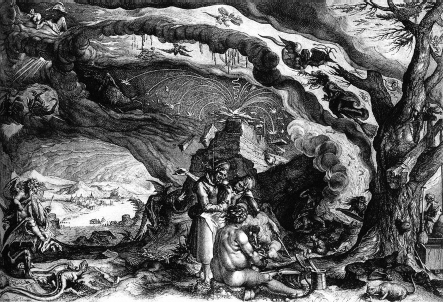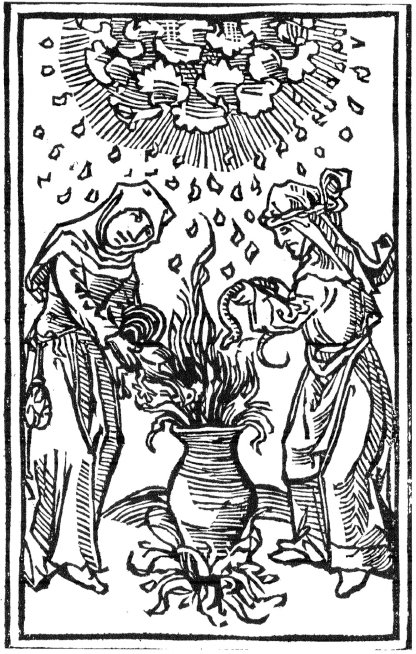
CHAPTER 8
The Wallingford Witch
Connecticut’s Final Witchcraft Trial
The Court…[advised] Winifred Benham solemnly to Reflect upon ye case and grounds of suspicion given in and alleged against her. And told her if further grounds of suspicion of witchcraft or further evidences should appeare against her by Reason of Mischief don to ye bodyes or estate…she might justly feare and exspect to be brought to her tryall for it.
—from November 2, 1692 hearing in New Haven Colony County Court
In many ways, Salem’s witch trials might have played as significant a role in changing Connecticut’s colonists’ minds about witchcraft as John Winthrop’s or Reverend Bulkeley’s urgings. Historians have recorded Connecticut residents describing the craze and pitch of Salem’s witch hysteria as a “miserable toil” and “great noise.” They read and listened to news of happenings in the “quarrelsome” village with as much skepticism as interest. This new attitude could have only benefited Wallingford’s Winifred Benham and her thirteen-year-old daughter, who, in 1697, were accused of using witchcraft to “misteriously [hurt] the Bodies and Goods” of several children.
The trial marked the third time mother Winifred King Benham had appeared in court for witchcraft. Some histories identify Winifred was the daughter of Mary Hale, a Boston woman accused and acquitted of witchcraft in 1668. But whether this is true is more interesting than influential. The first accusations against Winifred came in 1692—the same year as Salem’s trials—from neighbor Goody Parker, who, after Winifred’s case was dismissed, sought the “anxious solitude” of the Reverend Street, who then asked magistrates to reconsider Goody Parker’s claims of “many pecular things” about Winifred Benham.

Witches’ Sabbath, a 1610 engraving by Amsterdam’s Andries Jacobsz Stock, currently housed at Rijksmuseum—The Museum of the Netherlands.
Winifred’s husband, Joseph, responded to the claims by telling Goody Parker that if she made any more accusations, he’d load his gun with two bullets and use both of them on her. The threat required both Joseph and Winifred to appear in New Haven County Court, but no charges were formally filed on the grounds of insufficient evidence. However, Goody Parker’s claims, and Joseph’s actions, were enough to cast a shadow on Winifred. Rumors about her persisted, and the following year, she was in court again on witchcraft charges.
Like the first time, the charges were dropped, and Winifred was released, this time accompanied by a warning that if “further evidences should appeare,” she should “feare and exspect to be brought” to trial. Joseph was also required to post twenty pounds bond and promise that he’d ensure her good behavior.
Frustrated and alarmed—and no doubt prodded by Goody Parker—Reverend Street excommunicated Winifred, though the exact timing of this action is uncertain. Author George Munson Curits considered Winifred and Joseph’s state of mind in his Early History:
Presumably Joseph and Winifred breathed more freely…as they thought of the peril she had escaped. But her life in Wallingford could not have been pleasant thereafter. Her neighbors looked at her askance, and every act and word must have been scanned and twisted to suit the desires of those who sincerely believed she spent her nights riding on a broomstick in company with the devil. They had a daughter, Winifred, who must have shared much of the unhappiness of her mother’s life. This strained situation continued for five years with no outbreak.
Perhaps the Benhams were unkind or untidy neighbors, for their actions continued to be watched and scrutinized. They remained under suspicion of wrongdoing and, in August 1697, both Winifred and her teen daughter—also named Winifred—were charged with using witchcraft to afflict three children of prominent Wallingford families: Sarah Clark, sixteen; Elizabeth Lathrop, nineteen; and John Moss, fifteen. The two Winifreds were also accused of causing the death of a young child through the “appearance of spots.”
After “strict examination” of the “sufficient ground of suspicion,” New Haven County Court magistrates ruled the women should be tried as a capital case in Hartford. Joseph Benham paid the forty-pound bond needed to keep his wife and daughter out of jail for the two months that would pass before they appeared before the Generall Court of Assistants.
CONNECTICUT’S FINAL WITCH TRIAL BEGINS
No transcripts of the Benhams’ witchcraft trial exist. Yet in a December 1999 issue of the Record-Journal newspaper, staff writer Jeffery Kurz presented “an account, with certain Embellishments, of the Trial of the Benhams.” Titled “The Wallingford Witch Project,” the piece was the daily’s lead story at the top of page one and, after jumping inside, takes up all seventeen by twenty-two inches of the broadsheet page.
Even when the newspaper industry was booming, it was an enormous amount of space to give to a single story. But given that this one states from the get-go that it’s not all true—it’s “based on records available and with some fictional license to fill in the blanks,” Kurz said—the fact that it was given such play is puzzling. Clearly, much of the story came from Kurz’s imagination, though the details he includes show extensive research was performed. The piece also does an effective job conjuring how it might have felt to be within that 1697 courtroom:
Goodwife Hannah Parker is the first to speak. She stands before the judges and begins in slow, careful tones. But it is not long before her voice rises, as if carried away by the heat of passion.
It was to her house, she says, that the children first came. Hysterical, the girls with tears in their eyes, tearing at their own clothes as though they were trying to scratch an affliction from their bodies. She tried to calm them down, says Goody Parker. But it took a long time. The girls were so frightened. When they spoke, it was in unison, as though they were controlled by one mind.
“And what about the young master?” asks Governor Jones.
“He was frightened too,” says Good Parker. “Who wouldn’t be? But he’s a quieter sort, a thoughtful one. It was he who told me about the baby.”
“What baby?” asks the governor.
“The Royce child, the one who died last year.”
“He had the spots too, the same as them,” says one of the girls, Sarah Clark.
“Quiet child. You may speak when you are asked.”
“The baby had the spots,” Goody Parker tells the governor. “Same as them.” She points to the Benhams, mother and daughter, who sit across the divide with scant expressions. They stare straight ahead, keeping their eyes from their accusers. They know any reaction will be open to interpretation, and that there is no way to tell whether it will be favorable or not. Earlier, in Connecticut, not too far from here, a woman had been hanged for saying no more than that she did not believe in witches. Next to the girl, young Winnifred, is her father, who obviously shares no such sense of restriction. His face as red as a tomato in the sun, he repeatedly stamps the heel of his boot onto the hard wood floor waiting.
“Where were these spots?” asks the honorable governor.
“On the bodies of these two,” says Goody Parker, her voice rising.
“No,” he says. “I mean, where did you see them?”
“I didn’t see them,” Goody Parker says. “The children did.”
He turns to Sarah Clark, the one who had spoken up before. “And where did you see them child?”
“At night. She came into my room.” The girl’s voice trembles. “I thought it was impossible. But she was there. She showed me the spots. On her arms…”
The girl moves to the center of the room and points to the rafters, a look of terror on her face. “They were…in the air, suspended in a way that I didn’t understand…how could anyone do that?”
Some witnesses later said that at this they felt the odor of burning leaves enter the room, even though it was still summer and no leaves had yet fallen. This was attributed to the presence of the Devil in the courtroom that day.
“It was Satan,” Goody Parker says. “Satan who had sent them to you! Satan on whose behalf they came to gather you up.”
A voice rises like thunder from the other side of the room. “By God, I’ve had enough of this!”
It’s Joseph Benham, his voice shaking with fury.
“You will sit down sir!” roars the governor. “You will wait your turn, or I will have you removed from this court room.”
“These children are obviously being led,” says Benham. “Can’t you see that?”
“What I can see is a man who will find himself in irons. Your temper has cost you before. You are well advised to find a way of controlling it now.”
As Benahm sits, the governor addresses the children. “You know these are serious charges, that people have hanged for being in the control of the Devil. You know this, every one of you?”
The children stare at him. “I want you to speak. I want you to swear that what this girl, Sarah Clark, says is the truth, that each of you in the night have been visited by Goody Benham and young Winnifred Benham, or their apparitions on behalf of the Devil, and that you were afflicted with the mark of the Devil, that same marks being on them…”
“…but going away.”
“Going away,” says the girl. “The spots quickly vanishing. On the baby. The spots were there and then they were gone.”
“The spots quickly vanishing. Do you swear this is the truth?”
The children, one by one, softly, like a whisper, say yes. “Yes.” “Yes.” “Yes.”
The governor turns his head to the other side of the courtroom. “Now Goody Benham, what have you to say to these stories? Can you answer these accusations?”
How Winifred responded to these or any of the witchcraft accusations made against her is unknown. Like so many documents lost from the period, the records do not exist. What is known is that as part of prosecutors’ investigations, Winifred Sr. was searched for witch teats and underwent the water test. But apparently, if any evidence was found, it was deemed insufficient. According to the Records Court of Assistants, jury members returned the decision of “ignoramus,” meaning “we are ignorant of” or “not proven,” and dismissed the case.

Woodcut of witches adding ingredients to a cauldron, fifteenth century, author unknown.
The witchcraft trial of Winifred and Winifred Benham was the last to ever take place in Connecticut. In 1713, Bethiah Taylor of Colchester accused two of her neighbors—Sarah Clother and the wife of Thomas Brown, whose first name is unknown—of being witches. In 1724, Elizabeth Ackley of Haddam accused her sister-in-law Sarah Spencer of Colchester of “riding,” “pinching” and bewitching her. Elizabeth was married to Sarah’s brother James, who responded to the claim by threatening to harm his wife. Enraged, Sarah sued Elizabeth for £500 and presented the court with a certificate from her minister that vouched for her faith, piety and virtue.
Magistrates dismissed Elizabeth’s claim but ordered her to pay Sarah five pounds in damages plus all court costs. The Ackleys appealed, and Elizabeth pleaded insanity. The court, however, rejected the appeal, ruled that Elizabeth was not insane and stated that she was guilty of slander.
When the Connecticut Colony’s Generall Court released its updated list of “Capitall Lawes” in 1715, witchcraft was still listed as the number two offense. When capital offenses were next printed in 1750, the witchcraft law was gone. No legislative records show any kind of discussion or vote taking place. Judicial documents give no mention of the decision. Like magic, the law that led to panics, fear and the death of eleven Connecticut residents just silently disappeared.